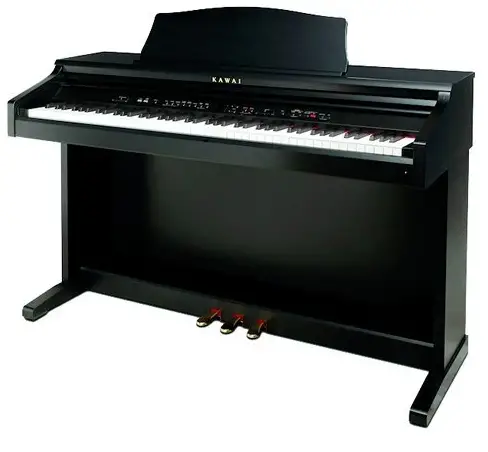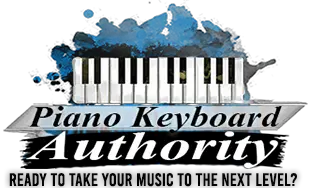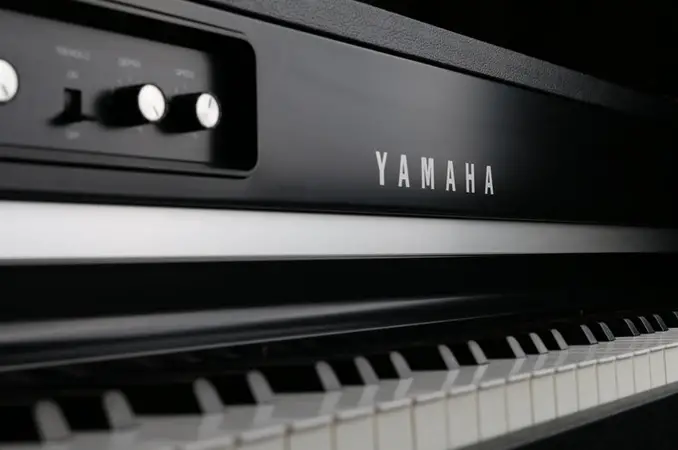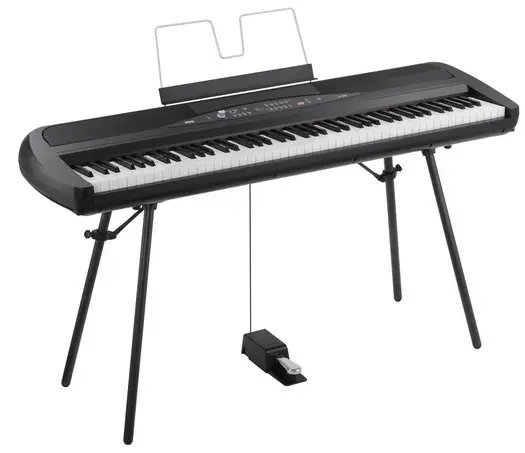Why do you need to find the best piano for a beginner? Pianos or keyboards are many times a musician’s first instrument they ever learn.
The foundation of playing a piano or digital keyboard can be administered in many other instruments, like a guitar. On a piano or digital keyboard each note is one key, making chords and scales easier to learn on them.
The piano is essentially the basis of learning other instruments, so now that you are considering buying a keyboard here is a guide to the best digital pianos for a beginner!
When choosing a keyboard for a beginner, there are two very important things to consider (well there are many things to consider, but the two most important things to consider is..)
You don’t want to get a digital keyboard too simple and with very little features that you would eventually become frustrated and bored with.
That being said, you also don’t want to spend too much money on a keyboard with features that beginners will have no understanding of. Too many features can become overwhelming and frustrating to a beginner.
One problem with learning to play a traditional acoustic piano is that is requires a very large and often times expensive piece of equipment in order to play. Modern digital keyboards have come to offer musicians the same dynamics of a traditional piano that are much more affordable and easily transportable. Digital keyboards are portable, and great for practicing with their wide selection of features and varying price ranges, you can become a regular Elton John or Mozart in no time!
There are many features and terms synonymous with most, if not all categories of digital keyboards. These are some basic features and terms you should become familiar with before you buy a digital keyboard. The complete guide to the best digital piano for a beginner!
Table of Contents
Things to consider when shopping for a digital keyboard
- The Number of keys
There are countless numbers of different digital keyboards out there, and with the many different types of keyboards, there are various numbers of keys on each keyboard.
Digital keyboards can range from 25 keys or small MIDI controllers to up to 88 keys on a digital keyboard.
The 88-key keyboard will be the closest feel to a traditional acoustic piano as a traditional piano has 88-keys as well. Purchasing a digital keyboard with 88 keys will make an eventual transition from digital piano to a traditional acoustic piano much easier.
Important things to consider when choosing how many keys you should get on your keyboard is which number of keys will be best for you space restrictions and the types of music you want to play.
Of course, less keys mean a smaller and more portable keyboard. Not to mention less confusing when learning the instrument.
If you have no desire to transition to a traditional piano, less keys are a better choice for you. Digital keyboards with less than 88 keys will allow musicians to play most lessons and chord progressions needed to learn, but the more complex and classical music requires all 88 keys to perform the music properly.
- Action
When researching the many different digital keyboards, you will notice the description explain the “hammer strikes” in the digital piano’s features. When pressing down on a key, the hammer strikes a string in the piano, creating the sound you hear when you press a key down. In order for this instrument to operate properly, tension must be present.
The tension that is created in the process of making the sound causes the keys to create resistance to the player’s fingers. There are various key actions that different digital keyboards offer. There is the semi-weighted action, the weighted action, the synth action and the hammer action.
Each of these actions offer a specific feel. Semi-weighted and weighted actions have very similar actions to acoustic pianos.
The hammer action option has actual mechanical hammers to enhance the keyboard’s response. The synth action is similar to an organ; there is no resistance in the action and the keys can be played quicker than the other actions offered.
For a true traditional piano feel, you will want a keyboard with semi-weighted, weighted or hammer action. If you are wanting to play more “fast lead passages,” a synth-action keyboard is the keyboard for you!
Again, if you plan on transitioning to an acoustic piano, playing with weighted or semi-weighted keys on your digital keyboard is the way to go. A hammer action in your keyboard adds actual mechanical hammers to enhance the traditional feel and response even more.
The smaller the hammer embedded in the keys, the closer the feeling and the response will be to the traditional piano.
The best digital keyboards will contain key beds that are “fully weighted.” These key beds will also have been known to be called a graduated weighted key bed that causes the keys in the key bed that have lower octaves, to have a greater weight, to imitate the heavier hammers and strings found in the traditional piano.
- Portability
Another thing to consider while searching for the perfect digital keyboard for you is whether or not you are going to travel with your digital keyboard. When you are traveling, take into consideration whether the place you are playing in will have easily accessible plug ins.
Researching the features in the different kind of digital keyboards are helpful as some keyboards than can operate with batteries or an AC adapter, so you wouldn’t have to worry about accessible plug ins.
- Storability
Digital keyboards are significantly lighter and more compact than traditional pianos, even the console models that contain a cabinet, meant to mimic a traditional piano, usually weigh much less than the acoustic pianos.
Along with the light weight, most digital piano models can usually be easily broken down and stored. Digital keyboards cost less than their traditional piano counterpart.
- Maintenance and tuning
Maintenance other than dusting the keys in digital keyboards are nonexistent. Acoustic pianos require tuning from time-to-time (a costly service) while the digital keyboards do not require tuning, as it is a digital machine.
- Volume control
Digital keyboard’s volume is easily controlled and changed on a wide range. Many if not most digital keyboards have a headphone input option so you can plug in earbuds while practicing the piano (and the rest of your household will thank you for using headphones.)
- Sound settings
The many sound settings built into the digital keyboards enables you to play sounds like percussion, strings, woodwinds and brass to your music, which can make playing the piano and creating music fun.
- Outputs and line-in features
Most digital keyboards come with a MIDI capability allowing you to connect to recording equipment and computers.
Many keyboard models also come with an USB output, creating an easy connecting process to external audio equipment.
The input and output section of your keyboard is definitely something you will want to consider when choosing the best keyboard for you if, you are planning to use your keyboard a digital audio workstation.
Having audio in and audio out features can save you from having to buy a separate interface. Audio outputs have the ability to connect the external amplifiers and speakers if you plan on playing in live performances.
- Dimensions
Check dimensions… make sure the keyboard you want will fit in the space you intend to play the keyboard in. If the piano is being purchased for a child, make sure you get the measurements of the height of the keyboard. You don’t want an instrument that is too big or high for the musician.
- Velocity-sensitivity
Another important feature to consider when looking for the perfect beginner’s piano is the touch or the velocity-sensitivity. Touch or The velocity-sensitivity is defined as the ability of a keyboard to sense the force or speed in which the key is being pressed, creating a sound or sending a MIDI message accordingly.
The higher-end digital keyboards are capable of sensing light differences in velocity that determine the volume of each note.
The cheaper digital pianos usually have volume level switches; which is a big indicator that this specific digital keyboard model does not have a real velocity-sensitivity.
The higher-end keyboards referred to before also contain volume controls that adjust the general output of the pianos, but the momentary volume on the keyboard models with real veolocity-sensativity is determined by how hard you strike each key.
- Sound quality
Digital keyboards sound quality usually depends on the samples used to create their sounds.
The technology used to capture and reproduce the sample sounds of the different pianos and other instruments, is a big component in how well the digital keyboard will emulate the different instruments.
Higher-end digital keyboards will contain more memory, allowing the keyboards to reproduce higher resolution sounds. The higher the resolution the sounds are, the more realistic the sound being reproduced will be.
- Polyphony
Polyphony is defined as the number of sounds a keyboard can generate at a single time.
Keyboards with more polyphony capabilities and sufficient instrumental sounds can mimic a complete orchestra. Minimum the keyboard should contain 32-note polyphony. A 64-note polyphony keyboard is a more adequate keyboard for creating a complex and smoother sound.
The higher quality digital keyboards can have from 128-not polyphonies to 264-note polyphony’s. But, the 64-note polyphony keyboards are more than enough to create the sounds you want.
- Number of sounds and tones
It’s a pretty cool thing to have a single instrument with the power to recreate hundreds of sound samples from the countless instruments like organs, accordions, synthesizers, flutes, guitars etc.
Once the excitement of creating music with tons of different sounds with just one machine wears off, you will more than likely find yourself playing only a select few and more basic piano sounds. Hundreds of tones and effects at your disposal can eventually become overwhelming and become distracting.
- Learning tools
Sme digital keyboards will include tools that can help you go from a beginner to an accomplished musician, and eventually become a Sir Elton John or a regular Mozart.
These tools include various playing lessons built into certain digital keyboard models, displays that show the chords being pressed by you and different lighting schemes that can help beginners choose chords and melodies more easily. Some digital keyboards contain a built-in metronome to help improve a beginner’s rhythmic skills.
- Amplification and speaker
If you are looking for a digital piano you will be playing mainly at home, you want to make sure your keyboard has a built-in amplifier and speakers that will produce a pleasing and loud enough to play your keyboard properly.
If you intend to play your digital keyboard at live performances or in a recording studio, be sure your digital keyboard has the output options for easy connectivity to amplifiers, recording consoles and PA systems.
- Multimbrality
Multimbrality is the ability of a piano to play different sounds at once like flutes, strings, percussing etc.… Though multimbrality sounds very similar to the polyphony, they are in fact different features.
- MIDI Capability
MIDI capabilities or musical instrument digital interface is a “communication protocol” created in the 1980s for computers and electronic instruments.
Musical instrument digital interface messages do not have sounds, rather the MIDI serves as a sound mechanism.
The MIDI serves as a blueprint to instruct a software or hardware instrument to which not to play and with what velocity.
So, in more simpler terms, the MIDI is pretty much the protocol that tells the digital keyboard which sound to make when pushing a particular key. The MIDI is the directions that tell the device what to do when a specific button is pressed.
- Computer Connectivity
With today’s technology, digital keyboards can now connect to computers in different ways. You can now connect your keyboard to a computer using a USB, Firewire, MIDI, S/PDIF, mLAN and many other interfaces.
These different interfaces can be external or built into the keyboard depending on the model you are looking to buy.
Most digital keyboard models will include a USB and/or MIDI as a way to connect your keyboard to a computer. But why would you ever want or need to connect your digital keyboard to a computer?
Well… with connectivity features, you can plug your keyboard in order to access recording applications, as well as cloud-based storage. Some high-end keyboards can offer iOS features that will enable users to access a whole world (or web) of performance and practice applications, and music collaborations are possible with these features. With today’s technology, digital keyboards can really do it all!
- Sequencer
A sequencer is a software or hardware device that will record MIDI performance data and can play the data back in an “user-programmed sequence.” This again is all thanks to the magic of modern technology that a simple piano has the ability to do all of this.
- Arpeggiator
An Arpeggio is defined as “a chord whose notes are played in succession instead of all at once.” So. an arpeggiator is a feature on certain digital keyboards that can electronically create an arpeggio when a note is played on the digital keyboard.
- Sampler
The sampler is a device that records digital audio and enables it to be changed and played back in different ways. If you plan to add external audio clips into your music (once you learn to play like a pro) you will want a keyboard with sampling capabilities built in.
- Controllers
There are many different controls offered on digital pianos and of course, each model has different controls.
When choosing a keyboard with certain controls, the specific controls that are important to have depends on what you will be doing with the piano. As you become more familiar with MIDI, you will want to have sliders and knobs. Many keyboards offer visual displays, some even offer touch screen capabilities.
- External Storage
Apart for being able to store the digital keyboard externally, you will need to know how much external storage your digital keyboard contains.
Most digital pianos offer types of external storage includes flash drives, compact flash disks, Secure Digital and Smart Media card slots. With digital keyboards that offer USB connectivity, you can transfer data between your computer and USB-enabled devices (as mentions before.)
Now, with everything to consider and as your brain is melting from digital piano information overload, we have a few digital pianos we recommend for you beginners.
Korg SP280BK 88-Key Digital piano with speaker
This is the least expensive choice on our list of recommended keyboards for beginners, but just because it cost much less than the other recommendations don’t mean it doesn’t pack areal keyboard punch.
For such a un expensive instrument, it offers a great and smooth sound, a wonderful feel that will not break your back when to drag the keyboard from gig to gig.
The Korg SP-280 is a keyboard created with modern performance traveling, keyboard players and pianists in mind. The SP-280 offers you 88 keys of Natural Weighted Hammer Action without the weight that makes you want to leave your instrument at home when traveling to a gig.
The SP-280 actually weighs a little less than 42 lbs. and this includes the keyboard’s stand and the built-in 2 x 22W stereo speaker system.
click here for more information!
 Korg SV-LBK 73-Key Stage Vintage Piano- Black
Korg SV-LBK 73-Key Stage Vintage Piano- Black
With an elegant matte black stage finish, the Korg SV-LBK will have you looking and feeling like a sophisticated concert pianist.
The SV-1BK Black contains 2 smooth grand piano sounds, 1 European and 1 Japanese sound. The Korg SV-LBK model contains a 73-key keyboard with Graded Hammer Action, 36 coveted piano and vintage keyboard sounds like the grand piano, smooth European piano, lively Japanese piano, a Mono Grand piano etc.
The Korg SV-LBK includes stereo inputs, stereo outputs (all 1/4″) • XLR stereo balanced stage/recording outputs and a headphone output. The Korg digital keyboard includes a damper pedal & a music rack. This digital piano will have you looking live performance ready in no time.
Click here for prices and information!
 Kawai CE220 Digital piano
Kawai CE220 Digital piano
The Kawaii CE220 contains the coveted wooden-key action, one that has been found on many award-winning Kawai instruments.
The wooden-key action feature is not new to the Kawai digital pianos, but the CE220 Kawai has added several other upgrades and new features to take this digital keyboard model to the next level.
The Kawai CE220 has a progressive harmonic imaging sound technology with 88-key piano sampling, which produces a more realistic and keyboard sound. The Kawai model contains USB to device capability.
This feature enables you to record a song or session to a USB memory stick. The recordings from the USB can be played on another instrument or loaded into a computer for printing a score or emailing to people.
Another upgrade the Kawai digital keyboard offers is its 192-note polyphony. A really cool feature the Kawai CE220 offers is both a Dual Mode, where two sounds are played at the same time, and a Split mode, where one sound plays on the left side of the keyboard and another sound plays on the right side.
This keyboard model contains great features for piano lessons and duets with its 4-Hands Mode, that creates two identical 44-note pianos on the keyboard. More learning feature offered from the Kawai digital keyboard is a built-in metronome with many different time signatures, 100 built in rhythms, 29 classical piano songs stored inside and a music book that comes with your purchase.,
check out the link to learn more!
 Yamaha CP4 Stage Piano with Natural Wood keys
Yamaha CP4 Stage Piano with Natural Wood keys
Yamaha is one of the largest acoustic piano manufacturers in the worlds. With a wide selection of grand pianos, Yamaha is able to create natural and detailed sounds heard on the Yamaha CP4 Stage Piano.
The Yamaha CP4 stage Piano also offers the 88-note wooden keys and graded hammer action to offer the ultimate piano touch and response.
The Yamaha CP4 is slim and lightweight making it portable and easy to store. The Yamaha digital keyboard offers an easy-to-use and understand interface with big lighted buttons for all the controls you will need, right at your fingertips. The Yamaha CP4 offers a wide selection of vintage electric pianos from many different eras.
click here for more information and prices



